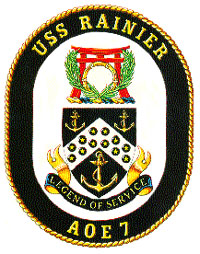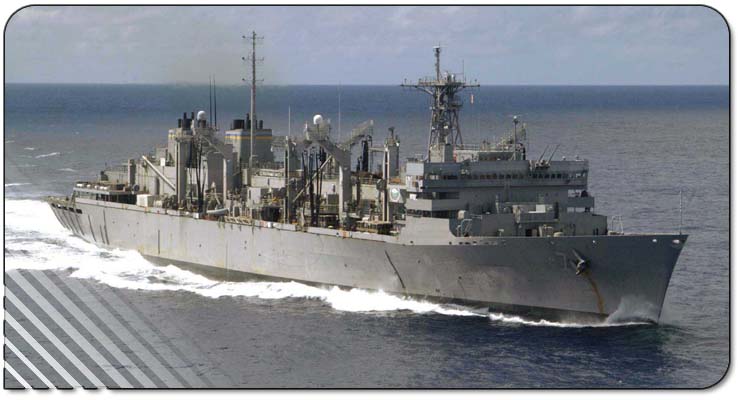Namesake:
Mount Rainier, WA
Mount Rainier, or "Tahoma" as it was named by the Northwest Native
Americans, was named after then Rear Admiral Peter Rainier, R.N. in
1792 by Captain George Vancouver. Born in 1741, Peter Rainier entered
the Royal Navy in 1756. He served on the HMS OXFORD, YARMOUTH, NORFOLK,
and BURFORD. In 1790 he commanded the MONARCH and early in 1793
commissioned the SUFFOLK which had 74 guns.
In 1799 Peter Rainier was promoted to the rank of Vice-Admiral. He was
stationed in the East Indies as Commodore and Commander-in-Chief until
1804. After his return to England and his retirement from active
service, he continued to be consulted by the ministry on questions
relating to the East India station. In 1805 he was advanced to the rank
of Admiral. He became a member of Parliament in 1807 and died in 1808.
USS RAINIER is the third supply ship to bear the name of Mount Rainier,
which is located in the state of Washington and is part of the Cascade
mountain range. The mountain is a volcano born of fire and built up
above the surrounding country by repeated eruptions and successive
flows of lava. It is a relatively young volcano, only about one million
years old. Mount Rainier is a 14,411 foot high volcanic peak along the
west side of the Cascade Mountains. It is the fifth highest peak in the
lower 48 states. On March 2, 1899 Mount Rainier became the fifth U.S.
National Park.
|
Historical Notes:
USS RAINIER (AOE 7) was constructed at National Ship and Shipbuilding
in San Diego, California and was commissioned January 21, 1995. It is a
SUPPLY class, Fast Combatant Support Ship, which is the first type of
deep draft vessels to have gas turbine engines. The AOE-7 contract
design was completed in February of 1986 and steel fabrication work for
RAINIER began on August 16, 1989 with the official keel laying
conducted on May 31, 1990.
RAINIER was built utilizing an efficient modular construction
technique. Separate sections of the ship were built with piping
sections, ventilation ducting and shipboard hardware, as well as major
machinery items such as main propulsion equipment, generators and
electrical panels installed.
These pre-outfitted sections were then brought together to form a
complete hull. As a result of this construction technique RAINIER was
nearly 50 percent complete when launched on September 28, 1991.
The next three years were spent completing the electrical wiring,
plumbing systems, ventilation systems and equipment and hardware
installation. During the final phases of construction, RAINIER went
through a series of dockside and sea trails to demonstrate its
capabilities and to ensure product quality.
Following commissioning, RAINIER began work-ups for an overseas
deployment. The ship departed its homeport of Bremerton, Washington in
November 1996 for its first deployment.
RAINIER deployed to the Arabian Gulf and Indian Ocean to provide fuel
and ammunition to US and Allied forces and successfully completed all
mission assignments there. Port visits were made to Singapore, Hong
Kong, and Australia.
RAINIER returned to Bremerton, and after a month of reduced operations
to let the crew recover, started the training cycle to prepare for the
November 1998 deployment. This training cycle included the RIMPAC 98
(Rim of the Pacific) exercise conducted with over thirteen countries.
RAINIER deployed to the Arabian Gulf and Indian Ocean for her second
deployment in 1998 to provide fuel and ammunition to US and Allied
forces. Port visits were made to Singapore, Thailand, Bali, and Darwin,
Australia. |
Ship's Crest:
 The Shield:
Dark Blue and gold are
the colors traditionally associated with the Navy. Gold is indicative
of honor, excellence, and achievement. The dark blue of the shield
stands for loyalty and reflects the sea, the theater of naval
operations. White suggests integrity and purity of ideals. Black
implies solidity. The chevron, a symbol of strength and support,
alludes to the prow of the ship and the peak of Mt. Rainier, the ship's
namesake. The black pellets characterize fuel and ammunition pointing
to the ship's mission. The pellets are charged with twelve battle stars
earned for World War II service in Korea and Vietnam. The three
anchors, symbolic of maritime tradition, simulate the past and present
ships. The Shield:
Dark Blue and gold are
the colors traditionally associated with the Navy. Gold is indicative
of honor, excellence, and achievement. The dark blue of the shield
stands for loyalty and reflects the sea, the theater of naval
operations. White suggests integrity and purity of ideals. Black
implies solidity. The chevron, a symbol of strength and support,
alludes to the prow of the ship and the peak of Mt. Rainier, the ship's
namesake. The black pellets characterize fuel and ammunition pointing
to the ship's mission. The pellets are charged with twelve battle stars
earned for World War II service in Korea and Vietnam. The three
anchors, symbolic of maritime tradition, simulate the past and present
ships.
The Crest: Red symbolizes combat,
valor and zeal. The colors red, yellow, and green are the colors
associated with Vietnam. The Torii gate recalls service in Korea. The
bamboo ammulled signifies continuous replenishment operations conducted
off Vietnam. The crossed palm fronds represent the ship's extensive
service in the South Pacific and portray strength, support, honor, and
achievement.
Motto: A scroll azure dubbed and
inscribed "LEGEND OF SERVICE" in gold.
|
PHOTOS
Click on images for larger view
|
More Photos: 1
| 2 | 3 | 4 | 5 |
6 | 7 | 8 | 9 | 10 |
11 | 12 | 13 | 14 | 15 | 16 | 17 | 18 | 19 | 20 | 21 | 22 | 23 | 24 |
25
|
|



 The Shield:
Dark Blue and gold are
the colors traditionally associated with the Navy. Gold is indicative
of honor, excellence, and achievement. The dark blue of the shield
stands for loyalty and reflects the sea, the theater of naval
operations. White suggests integrity and purity of ideals. Black
implies solidity. The chevron, a symbol of strength and support,
alludes to the prow of the ship and the peak of Mt. Rainier, the ship's
namesake. The black pellets characterize fuel and ammunition pointing
to the ship's mission. The pellets are charged with twelve battle stars
earned for World War II service in Korea and Vietnam. The three
anchors, symbolic of maritime tradition, simulate the past and present
ships.
The Shield:
Dark Blue and gold are
the colors traditionally associated with the Navy. Gold is indicative
of honor, excellence, and achievement. The dark blue of the shield
stands for loyalty and reflects the sea, the theater of naval
operations. White suggests integrity and purity of ideals. Black
implies solidity. The chevron, a symbol of strength and support,
alludes to the prow of the ship and the peak of Mt. Rainier, the ship's
namesake. The black pellets characterize fuel and ammunition pointing
to the ship's mission. The pellets are charged with twelve battle stars
earned for World War II service in Korea and Vietnam. The three
anchors, symbolic of maritime tradition, simulate the past and present
ships.


















